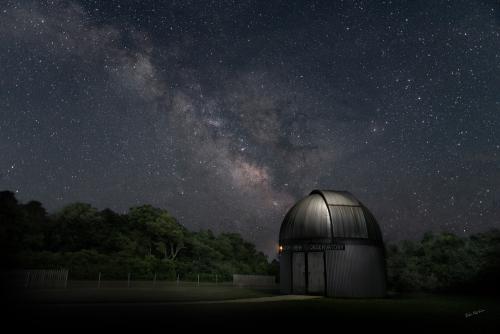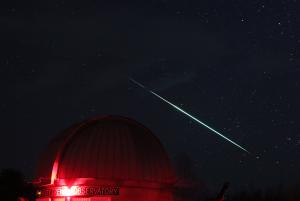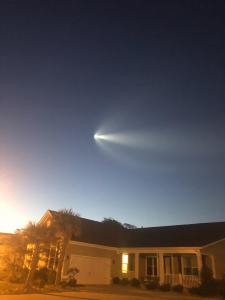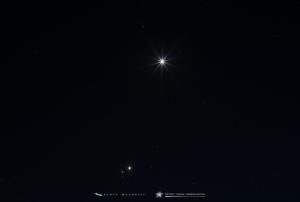Celebration of Space - February 17, 2023

The Milky Way over Frosty Drew Observatory on a night with no Moon. Credit: Bob Mattera
On Monday, February 20, 2023 at 3:09 am, the Moon will arrive, in its orbit, in between the Sun and Earth. We call this “conjunction”, but you may better know it as the New Moon. On the day of the New Moon, the Moon will rise and set with the Sun, leaving the nighttime period completely free of moonlight, making it the darkest night of the 29.5 day lunar synodic period. The New Moon may be the darkest night, but contrary to popular belief, it is not the only night that you can experience fantastically dark sky conditions from sites that are free of light pollution. After the Moon reaches its full phase, the Moon will begin to wane, and rise later with each passing night. This will allow for dark sky viewing in the evening hours after twilight wanes, and before the Moon rises. Eventually the Moon will retreat into the morning sky as it passes third quarter, and becomes new. After the New Moon, the Moon will begin to set later with each passing night, giving sky watchers plenty of dark sky viewing opportunities from Moonset until pre-dawn.
Monday’s New Moon is also happening about 23 hours after the monthly lunar perigee, which is when the Moon is closest to Earth in its 27.3 day orbit. Like a supermoon, this occurrence also happens during the Spring Tide, which happens during the full and new moons. Maybe it would be appropriate to call Monday’s Moon a Super-new Moon? In any case, be sure to find some time this week to visit a dark location and celebrate your view of thousands of stars.
This past Sunday, February 12, 2023 at 9:59 pm ET, an object named 2023 CX1 entered Earth’s atmosphere and broke apart over the coast of Normandy, France. The object was previously classified as a near-Earth asteroid (NEA) with an Earth-crossing orbit. The asteroid was rather small, and more like a large meteor with a diameter of about 3 feet. The object was discovered less than 7 hours before the encounter, and notifications were sent out via social media by the European Space Agency (ESA). Numerous photos were captured of the object, from all over Europe, as it entered the atmosphere and burned up. The view would have been comparable to a very bright fireball meteor. For comparison, the Chelyabinsk Meteor that exploded over Chelyabinsk, Russia in February 2013 was 59 feet in diameter. Here is a quick video of 2023 CX1 entering Earth’s atmosphere. Hey, keep your eyes on the sky!
Tonight, Friday, February 17, 2023, starting at 10:59 pm ET, the launch window will open for the SpaceX Falcon 9 rocket, which is sending the Inmarsat 6 F2 comm satellite into orbit. The launch will happen at Cape Canaveral, FL, and the launch vehicle should be visible to sky watchers along the East Coast, US, including Southern New England. The launch window will stay open until 12:28 am ET on February 18th, depending on launch conditions. Most people have, at least, seen a picture of the SpaceX Falcon launch, as it is what usually launches Starlink satellites into orbit. Though most images you see are taken either just after sunset or just before sunrise, when the launch vehicle is in direct sunlight, while the observer is in twilight. This will cause the launch vehicle to become exceedingly visible, as well as the exhaust plumes of the rocket. Having the launch happen closer to midnight, will keep the launch vehicle out of direct sunlight, and the only component an observer will likely see will be the light emitted by the rocket itself. Regardless, this could be a good opportunity to catch a view since the sky should be clear by that time. To see it, set out to a location with a wide open view of the southeast sky, and be set up and ready to view before 10:55 pm. About five minutes after launch the rocket should become visible, heading towards the northeast sky. Let us know if you happen to catch a view of the launch.
Over the past month, Venus has become quite visible in the southeast sky after sunset. Appearing like a bright beacon or airplane, Venus will outshine everything in the night sky aside from the Moon. If you have been watching, you probably have noticed that Jupiter has been quickly approaching Venus in the evening sky. Over the next two weeks, both objects will continue to close in on each other, visibly. The closest visible approach will occur on March 1, 2023, where Jupiter and Venus will appear about half of a degree from each other. This fabulous conjunction will really start to take off later this coming week, and will continue well into March. The Moon will join in the party on February 22nd and 23rd, offering a view of the thin crescent Moon among the planets. These dates present some excellent viewing and photo opportunities. So, gear up for another stunning planetary conjunction.
- Author:
- Scott MacNeill
- Entry Date:
- Feb 17, 2023
- Published Under:
- Scott MacNeill's Columns




